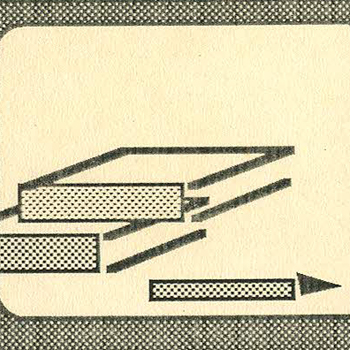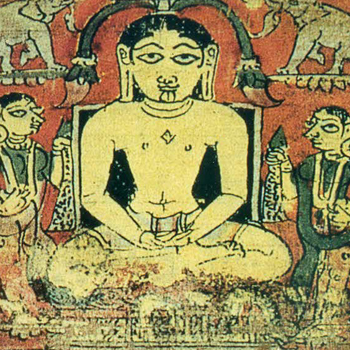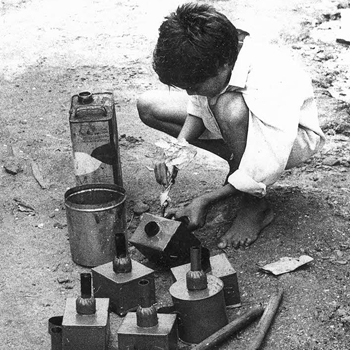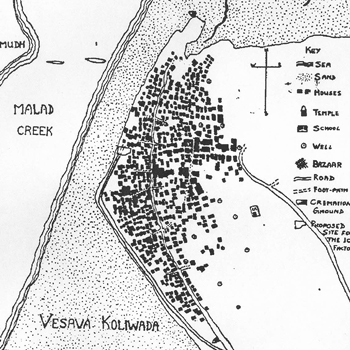Communication Design
Batch 1989-1991
(6 items)
Communication DesignBatch 1989-1991
(6 items)
(6 items)
by Madhava Hebbar
Evaluate, evaluate, evaluate! was that morning alarm... I think I started off... What to evaluate? My dreams.
Morning 9.15, i was at IDC... actually working on my project 3 on type design... and that durable day was my first presentation of this seminar project... yes.. but then... it matters less... as i had proceeded into main designing of the letter form... once something starts it never will have problem... thought over is clear... not to call it crystal clear... yes maybe, spectrum clear ! .Then, on that favourable day, I was to be faced with a presentation of the basic outline and aim as a whole. I knew it. I had prepared a bit; my guide was always there: omnipresent, omnipotent. I had just spoken a day before, Ravi. What do you expect of me, young lady? What am I supposed to do? and I feel he was crystal clear, as whenever he was dealt with, he briefed
Apply the model you have suggested to those films, from IDC, perhaps, or Reddy's film, or your film; do it at TISS; take help; At least by the end, you must have set a base for future application; you may have to see how design as a whole is evaluated and whether the same is true in the context of films. said I went and gave the presentation. There were quite a few people around. I talked a bit.. to tell what I had discussed... pow came few suggestions... one even insisted not to evaluate my film as I may get biassed...
From that day on, I made up my mind to do a little bit of work on it so that I could present on time, but then hurdles took over, which may take pages to complete but may not be worth a penny! So today, the 26th of September 1991, when 80% of the work is complete, though not the way it should have been, as the executor strayed into areas of associated topics, such as problems and wicked problems, feedback, operations research, and so on, it seemed an interesting yet never-ending topic to operate on, untill my guide Siren decided to end the reference and come out with conclusions, which include the following:
the main feature of the project, "The Evaluation Model," so the work of compilation started.
What ever was dealt with in the books has been reduced to a taxonomical structure of charts; they have been structured in parts with minimal explanation; this whole report thus remains as a base for further initiatives.
Though it could be quite taxing to go through the pages filled with taxonomical charts, it could just be helpful as reusable material.
Bibliography takes a frontline position as it could be a glance through material that is not to be missed... and also because this report is almost a reduction of what has been dealt with in those papers or books and is of prime importance to the future user.
Further, before I end, the last line as a forte is in Avant-Garde bold, i.e., evaluation keeps design alive.
by Ajay A Thombre
With its strangely attractive land encompassing extremes of geography and climate, colour has always been an intrinsic facet of Rajasthan. In its art and architecture, in its rites and rituals, and in the clothing of its people, colour symbolically represents the life-spirit in a myriad of forms and shapes.
Rajasthan has played an important role in the history and developments of Indian art from the earliest times. The Rajasthani genius was at work in the Ghaggar basin in the northwest, where the Harappan civilization flourished. It was at work also in the Chambal valley to the east, where numerous caves and rock shelters with prehistoric and early historic paintings have come to light.
The tradition grew vigorously in everyday rituals, in the embellishment of dwellings and household objects, and in the illustration of palm-leaf manuscripts. Illuminated manuscripts and painted manuscript covers dating to the eleventh century are preserved in the Jain repositories at Jaiselmer. Contemporary texts like the Kuvalayamala Kaha, written in A.D. 778 at Jalore, tell us about wall paintings that existed at that time. The palm-leaf manuscripts of Ogha-Nirukta and Dasa-Vaikalika-Tika copied in 1060, followed by Savaga-Padikkamana-Sutta-Chunri painted in 1260 at Aghata, modern Ahar in Udaipur, under the Guhila king Tejsimha, gave place to numerous paper manuscripts prepared in the following centuries. References to wall paintings have also been found in an account of Sultan Jala-ud-din Khalji's Rajasthan conquest between A.D. 1290 and 1296.
This period was followed by one of the most confused political environments, and it is difficult to identify the painting styles that flourished in different parts of the state. Some scholars attribute the paintings of the Chaurapanchasika and the Laura-Chanada manuscripts and the distinct style of these and some related paintings to the Mewar-Malwa region. In view of the fact that paintings—both mural and miniature—are produced at Chavand, Chitor, and some other centres of Mewar, the possibility of the latter, with its rich cultural, literary, musicological, and religious attainments, being a strong centre of art activity cannot be ruled out.
The socio-cultural development of the fifteenth and sixteenth centuries provided an ideal background for the growth of flourishing schools of painting. Painters took delight in drawing colourful paintings of Radha and Krishna from Jayadeva's Rasikapriya. Romance and poetry also dominated the literary and artistic creations, and many sets of Ragamala (visually depicting musical modes) or Nayaka-Nayika Bheda (the moods of the hero and heroine) or Baramasa (paintings depicting the characteristics of the twelve months) were produced.
by Johnson Pathrose
We speak when we are awake, and we speak in our dreams. We are always speaking, even when we do not utter a single word aloud but merely listen or read, and even when we are not particularly listening or speaking, we are continually speaking in one way or another. We speak because speaking is natural to us.
What is speech ? Speech is the audible expression and communication of human feelings. Thus, feelings are accompanied by thoughts. Hence, it cannot surprise us that as soon as a man looks thoughtfully at himself or his surroundings, he quickly hits upon the language. So, when language is spoken, it is an expression, a human activity.
An abiding activity of humans in all societies is to distinguish themselves from lower animals. All societies have creative myths that tell how the world and the people and animals in it came into being. These myths identify traits unique to humans, distinguishing features that separate humans from animals. Understandably, language is frequently included among these traits.
by Marion Hendricks
This project is a two month project and is research oriented. Unlike the previous two projects, which were practical exercises, this project is aimed at making a thorough theoretical study and producing a report at the conclusion of the stipulated time. My aims in taking up this project were my long-standing interest in exhibition design. The idea in mind is to gather together all available information that will be useful to a designer who is putting up an exhibition on an international scale. This information will attempt to cover all aspects that an exhibitor may have to come across in the designing as a successful exhibition. It is intended to serve as a guide for all the necessary activities, right from the selection decision to the dismantling and removal of the exhibits. A special attempt has been made to give a detailed picture of how designers play a vital role in the success of any exhibition, from the conceptualising of the basic layout, the designing of the stands and panels to the minute details like colour and the type of fabric used to cover the floor. The ultimate aim of the project is to compile all this information into a booklet that can be referred to for any relevant information.
by Sudeep Dasgupta
Some years back, when I was in school, I visited an archaeological site at Purana Quila. The excavations were carried out there since 1969, started by the renowned Prof. B. B. Lal of the Archaeological Survey of India, and continued for a few years.
This had revealed a vast treasure of excavated human settlements that dated back hundreds of years before the birth of Christ. The exhibit of the pottery and the other excavated material there fascinated me enormously.
This was the very reason that inspired me to take up a project on this subject. I am extremely thankful to Prof. S. Nadkarni for having realised my keenness in this matter and allowing me to take up this project.
This project is divided mainly into two parts:
I - A basic introduction to excavation and archaeology
- Various factors that lead to an excavation and the method and technology involved in it
- Excavation technology
- Recording of archaeological finds
- Dating methods
- Preparing a report on excavation
II A study on the excavations carried out at Purana Qila.
by V J Mohan
In the premier city of India live the Kohlis, a fishing community possessing a distinctive culture of its own.
They were some of the earliest inhabitants of Bombay. The people are lively, full of enthusiasm, and have a zest for life. These honest and God fearing children of the sea constitute an important part of Maharastra's life. Although, due to the constant and intimate contact with urban groups, the Koli culture has undergone change, the process of adopting foreign traditions has been gradual and selective. The core of the tradition and culture has been preserved.
Some of the areas covered by me are etymology, early history, internal structure, marriage, divorce, childbirth, religion, social statistics, and the types of open spaces and the activities that take place within them.





